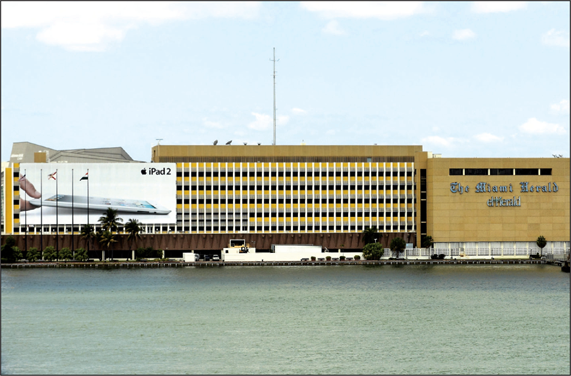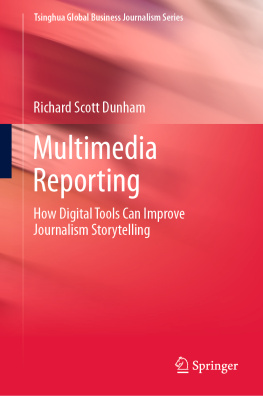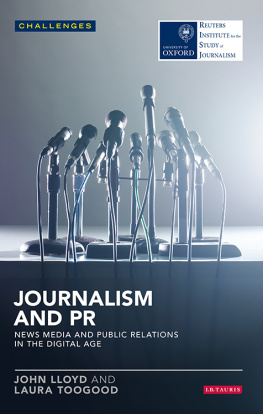The Story So Far
What We Know About the
Business of Digital Journalism
Columbia Journalism Review Books
Series Editors Evan Cornog and Victor Navasky
The Story So Far
What We Know About the
Business of Digital Journalism
A REPORT BY
Bill Grueskin
Dean of Academic Affairs, Columbia Journalism School
Ava Seave
Principal, Quantum Media
Adjunct Associate Professor, Columbia Business School
Lucas Graves
Ph.D. Candidate, Columbia Journalism School

Columbia University Press
Publishers Since 1893
New York Chichester, West Sussex
cup.columbia.edu
Copyright 2011 the Tow Center for Journalism at the Graduate School of Journalism, Columbia University in the City of New York
All rights reserved
Library of Congress Cataloging-in-Publication Data
A complete Cataloging-in-Publication record is available from the Library of Congress
ISBN 978-0-231-16027-8 (pbk.: alk. paper)
ISBN 978-0-231-50054-8 (e-book)
Columbia University Press books are printed on permanent and durable acid-free paper.
Printed in the United States of America
References to Internet Web sites (URLs) were accurate at the time of writing. Neither the author nor Columbia University Press is responsible for URLs that may have expired or changed since the manuscript was prepared.
Few news organizations can match the setting of the Miami Herald. The paper's headquarters is perched on the edge of Biscayne Bay, offering sweeping views of the islands that buffer the city of Miami from the Atlantic Ocean. Pelicans and gulls float near the building; colorful cruise ships ply the waters a few miles away.
And Miami Herald executives long held some of the best views in the city, from the fifth floor of the company's headquarters.
Not any longer.
The Herald, like most U.S. daily newspapers, has faced severe financial troubles in recent years, suffering deep cuts in the newsroom and other departments. So, in one of many efforts to raise revenue, executives attached a billboard to the east side of the Herald building, completely obscuring the bay views of many newspaper employees, including the publisher.
The benefits of the billboard are obvious: the low six figures in annual revenue, according to a Herald executive, or enough to pay the salaries of a few junior reporters.
The irony is obvious as well, for the advertiser buying the space is Applethe company that now controls a commerce and publishing system crucial to the future of the news business. And the product being advertised on the Herald's wall is the iPad, a device that is both disruptive and helpful to media economics.
Indeed, the two companies provide a way to see the destruction and creation in the media business over the past decade. At the end of March 2001, the stock market valued the Herald's parent company, Knight-Ridder, at almost precisely the same amount as Apple: $3.8 billion.
Ten years later, Apple's valuation is more than $300 billion. And Knight-Ridder no longer exists as an independent company.

Miami Herald building, with Herald logo on right and Apple iPad billboard on left, April 2011 (Jeff Binion photo)
* * *
The difficult financial state of the U.S. news industry is no longer new. Most big newsrooms have faced severe cutbacks, and even though online-only outlets have sprung up in communities throughout the country, they haven't fully taken the place of what has been lost.
These issues were explored in a precursor report to this one, sponsored by Columbia University's Graduate School of Journalism and written by Leonard Downie Jr., former executive editor of the Washington Post, and Michael Schudson, a professor at Columbia. At the end of that report, which was published in late 2009, the authors provided a number of recommendations to stanch the losses in independent reporting.
Most of the recommendations were based in policy, including changes in the tax code to provide news organizations easier access to nonprofit status and encouraging philanthropists to support news gathering. Most controversially, Downie and Schudson recommended the creation of a national Fund for Local News supported with fees the Federal Communications Commission would collect from telecom users, broadcast licensees or Internet service providers.
That suggestion drew praise from some, as well as criticism from those who saw it as an intrusion by the government in a free and robust press. In the words of Seth Lipsky, editor of the New York Sun, The best strategy to strengthen the press would be to maximize protection of the right to private propertyand the right to competition. Subsidies are the enemy of competition.
This report stands on the shoulders of the first one, but takes a different approach. Without addressing the merits of philanthropists or governments supporting news gathering, we wanted to address another question: What kinds of digitally based journalism in the U.S. is the commercial market likely to support, and how?
While this report will examine some traditional, or legacy, business models for media, our focus is on the economic issues that news organizationslarge and small, old and newface with their digital ventures.
This report focuses on news organizations that do original journalism, defined for our purposes as independent fact-finding undertaken for the benefit of communities of citizens. Those communities can be defined in the traditional way, by geography, but can also be brought together by topics or commonalities of interest. We also look into media companies that aggregate content and generate traffic in the process.
We confine our report mostly to for-profit news enterprises. We recognize the outstanding work done by such national organizations as ProPublica and the Center for Investigative Reporting, as well as local sites like Voice of San Diego and MinnPost. But for the purposes of this study, we felt it was more valuable to spend our time examining organizations that rely as much as possible on the commercial market.
We do have a bias: We think the world needs journalism and journalists. We welcome the tremendous access people now have to data and information, but much of what Americans need to know will go unreported and unexposed without skilled, independent journalists doing their work. That work can include reporting and editing in the traditional way, as well as aggregating information from other sources, or sorting and presenting data to make it accessible and understandable.
We decided to restrict our studies mostly to the U.S. market. We found the domestic news scene to be a rich and textured one, with plenty of complexity of its own, though we appreciate that a great deal of innovation is taking place beyond U.S. borders.
We define digital journalism broadly. While many publishers still see it as an online phenomenonthat is, displaying content on a PC screen via the Internetwe have included other platforms, including mobile phones and tablets.













